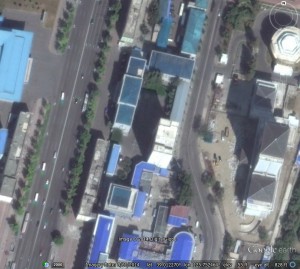The United Nations aid program for malnourished North Koreans may close after raising only a fraction of the money it needs to operate in the country, a senior U.N. official said in a call for donations.
“We may need to scale down or think about closing altogether,” Dierk Stegen, the Pyongyang-based North Korea head for the U.N. World Food Program, said in an interview.
The agency, which has operated in North Korea since 1995, could shut early next year if there is no indication it will be able to raise needed funds by the end of October, he said. One complication is that North Korea’s humanitarian crisis has been overshadowed by the conflict in Syria and Ebola outbreak, he said.
While North Korea is getting better at feeding its people, hundreds of thousands of young infants and their mothers remain chronically malnourished, he said.
Contributions from private organizations and the South Korean government in recent weeks have helped, but the program is far from its goal of $50 million, already a significant reduction from the original target of $200 million it set last year.
The North Korea food-assistance program has drawn flak from critics who say the regime takes advantage of the agency’s largess, devoting its resources to developing its nuclear weapons program and constructing amusement parks while its people suffer. Critics also say the agency can’t be sure its assistance is reaching the intended recipients.
Nicholas Eberstadt, a political economist at the American Enterprise Institute in Washington who has studied North Korea’s food situation, said that the WFP’s work in the country was “a disappointment—perhaps a terrible disappointment,” arguing that the agency has put up little resistance even as Pyongyang restricts oversight from foreign aid groups.
“Outside humanitarian assistance will not work in North Korea unless it is ‘intrusive’—and the WFP has no stomach for such work,” Mr. Eberstadt said.
Mr. Stegen acknowledged past shortcomings in its ability to monitor the distribution of its aid, but blamed a lack of funding and cited recent improvements in its access inside the country. He said that the WFP can now get permission within 24 hours to visit any school or household that is receiving its aid. In the past, two weeks’ notice was required.
Mr. Stegen said that criticism of a government’s priorities isn’t unique to North Korea, and urged donors to prioritize vulnerable infants over politics.
“Intervention and assistance on a humanitarian basis should be separated from political things,” he said.
Earlier this month, South Korea’s government approved $7 million in new funding to the WFP, its first such contribution since 2007. While South Korea’s conservative government has talked tough on North Korea, it has also pursued a policy of “humanity” toward the North, particularly infants and young mothers.
The U.S., by far the largest donor to the WFP’s North Korea work, hasn’t contributed since 2009, when Pyongyang tightened its rules on monitoring food aid by restricting the number of Korean-speaking monitors allowed into the country, according to a U.S. Congressional Research Service report published in April.
The WFP’s fundraising efforts have also been hampered by rising awareness of North Korea’s human-rights violations. Earlier this year, a special U.N. commission published a landmark 400-page report which said the regime selectively starves its population based on factors like political loyalty, and recommended the U.N. Security Council refer Kim Jong Un and other senior officials to the International Criminal Court.
Ahead of the U.N. General Assembly, U.S. Secretary of State John Kerry on Wednesday called North Korea’s system of prison camps “unfathomable” and a sign of what he described as “barbarity, inhumanity—I think you can call it evil.”
Mr. Stegen said North Korea had markedly improved its capacity to produce food for its people since a devastating famine in the 1990s. He said that fewer people in the country remain hungry today, even as the population has increased.
But he cautioned that the country’s agricultural efforts have focused too much on producing rice and other grains, at the expense of protein. That has led to malnourishment of infants and children under the age of four, he said, putting them in danger of stunting, even as Kim Jong Un has made a public show of encouraging fisheries as a potential source of protein.
“For many of the children of North Korea, it’s already too late,” said John Aylieff, the WFP’s deputy regional director for Asia. “They’ve been dealt a life sentence of impaired mental functioning and impaired physical development.”
A drought earlier this year has also meant a throttling back of government rations to ordinary citizens, which fell to about 250 grams a day, Mr. Aylieff said. That is less than half the targeted rations, and the lowest in several years.
As a result, the aid agency is expecting a surge in acute malnutrition this year. “We hope potential donors will see the humanitarian imperative,” Mr. Aylieff said.
Marcus Noland, an economist and North Korea expert at the Peterson Institute for International Economics in Washington, said that given the WFP’s funding problems, its ability to monitor its work would be limited.
“Trying to maintain an underfunded program in that environment is practically inviting an aid diversion scandal,” he said. But the WFP’s absence from North Korea would also likely exacerbate any food crisis.
“The advantage of having the WFP in-country in even a limited capacity is that they are pre-positioned to monitor conditions and respond if there is an emergency,” Mr. Noland said.



